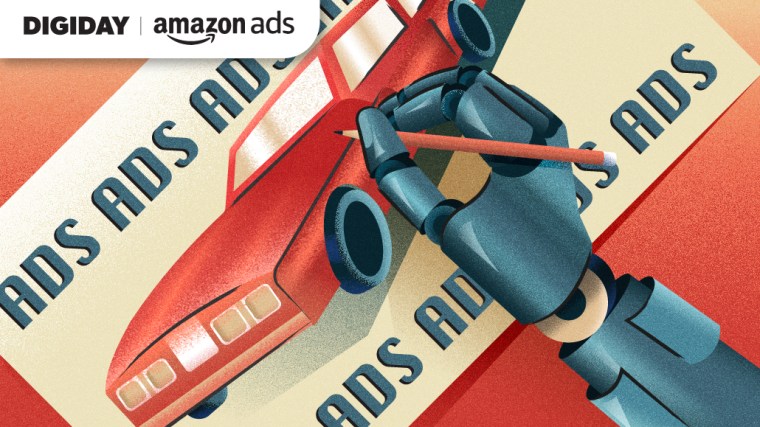
This Tactics + Insights guide, sponsored by Amazon Ads, explores how brands leverage generative AI to unlock more efficient ad creation, drive creative transformation and optimize ad creatives.
Successful ad creative differentiates products and empowers advertisers to stand out in the competitive marketplace; however, brands face two prevalent challenges when devising, designing and deploying ad creative that can achieve these two goals.
First, smaller organizations often need more access to creative teams and technology. Second, even though larger organizations typically have greater access to these resources, they need help producing creatives quickly in response to market conditions.
Furthermore, advertisers need creative optimization tools that keep their campaigns reactive and effective. This usually requires numerous versions of campaign ads and staff that can swap out iterations based on ad performance in close to real-time.
Creative transformation addresses these critical challenges by using automation to replace manual creative processes that can lead to burnout or be challenging to accomplish with smaller teams. By embracing creative transformation, teams enhance the efficiency and scalability of ad creation and produce standout, differentiated ad creative that flourishes in a competitive marketplace.
“Before AI-generated creative applications came to be, there was a lot of friction in the creative process,” said Jay Richman, vice president of creative experiences at Amazon Ads. “For an ad to run across a range of ad supply, the advertiser needed to build the creative to spec for each ad placement, exchange or DSP it would run on. In many cases, that would mean manually modifying that creative to meet a variety of aspect ratios and resolutions before the ad campaign could be set live. Now, with just a few clicks, advertisers can transform a single product image into rich, engaging brand imagery in multiple ratios and resolutions, ensuring their creative content remains clear and compelling across various channels.”
In this tactical guide, Digiday and Amazon Ads explore how brands leverage generative AI to unlock more efficient ad creation, drive creative transformation and optimize ad creatives.
Generative AI’s role for writers and copy is already on its way to becoming endemic, and its effectiveness in creating images and videos is growing. For example, AI-powered image generators can ingest product details, short text prompts and other information to generate multiple image options quickly, allowing teams to test and optimize performance.
The first step in utilizing generative AI for image generation is writing effective image prompts. Successful prompts are clear and specific, including audience considerations, context and usage. But they also fall within certain boundaries.
To achieve prompts that deliver powerful ad-creative outcomes, successful teams start by defining the purpose of the image, specifying the key elements they want to include and providing details about their brand’s colors, logos and other information. They build on this initial prompt by adding their target audience demographics and the desired tone and style of the ad. From there, teams specify the platform on which the image will appear and any desired CTAs.
“To get the optimal output, it’s best to ensure prompts are specific, concise, unambiguous and output-focused,” said Richman. “A framework we like to use on my team to describe what the model should create is to specify what you want the scene to include (the subject), where the elements of the scene should be placed (the location) and how you would like the scene to be composed (the description of the scene).”
For example, simply telling the tool to make an image of a coffee cup is almost always too vague. Adding descriptors that deepen the ask, such as “a retro-style image of a coffee cup on a table in a café next to a window with a city view in the background,” is key to creating prompts that generate rich outcomes and fuel creative transformation with quicker steps and fewer iterative stages. However, going into too much detail, such as outlining a whole scene element by element, often results in the tool cutting off the prompt at some point or ignoring portions of it entirely.

Once the proper specificity is understood and a balance of detail and concision is achieved, the desired image aspects can be sequenced by priority.
This can be a crucial step because the order in which brands describe the desired elements in an image prompt often influences how generative AI tools prioritize. For example, if a brand generally emphasizes a specific image style, the creative team should specify the elements of the target look and feel within the prompt. On the other hand, if the prominence or showcasing of a product, person or object itself is more important, then describing that before developing the setting in the image is the proper order for the prompt.
Tactics like these help drive results like the outcomes Trellis, an Amazon Ads partner, achieved in Q3 2024.
Trellis’ team uses Amazon Ads to help its selling partners scale their businesses through automated AI-driven campaigns and planning. Trellis’ selling partners need to quickly and easily create seasonally relevant and captivating campaigns. So, to make things even easier for its partners, Trellis integrated Image generator to create more than 200 image variations for its selling partners to choose from. This helped them develop new campaigns and achieve a 60% CTR increase and a 52% conversion rate lift over their benchmark. This integration allows Trellis’ partners to launch effective campaigns in only a few minutes.
An Amazon small business customer, Gelle Freres — a French skincare company — also used Amazon Ads to capture a seasonal moment using the new AI Video generator solution.
“As a skincare and cosmetics brand, running promotions on Amazon, especially for Black Friday, is a priority,” said an executive at Gelle Freres. “With Video generator, I was not only able to instantly generate videos for these campaigns, but it also opened up more possibilities — giving me the ability to run video ads for products I couldn’t have before. Video generator significantly reduced the time needed for the video production process, which is a huge win for our business.”
The ability to quickly create multiple iterations of images and videos that can be used to optimize ad campaigns based on seasonality, performance, audience preferences, etc., especially by leveraging automation, is at the heart of creative transformation.
“We lean in heavy on micro seasons, as well as work to align our imagery with each aspect of our targeting, rather than relying on a few assets targeting a broad audience,” said BTR Media’s CEO, an Amazon Ads partner. “For example, we prefer having different creative assets when targeting the search term ‘Soccer’ vs. ‘Soccer ball for girls.’ This allows our ads to be more dynamic, and aligned with the search preferences, thus increasing CTR and CVR. Refreshing content at scale for both micro seasons and specific audiences would be incredibly difficult/near impossible without AI.”
Once advertisers have launched their campaigns, generative AI tools help their teams fine-tune their ad creative. Teams are streamlining their optimization processes while campaigns are in flight by engaging with generative AI tools that accelerate A/B testing and using the results to produce better campaigns.
For example, generative AI tools enable teams to produce multiple versions of ad creative and automate A/B testing across ad placements to identify which creative works best overall. Teams also use iterative learning to test results and determine which ad elements were most effective, including what worked best regarding objects, backgrounds, lighting, contrast and more.

“Advertisers leveraging AI-generated creative can strategically allocate their budgets toward those that perform the best,” Richman said. “This practice optimizes resources and helps enhance overall campaign effectiveness. We’ve witnessed brands and partners seamlessly aligning their imagery with keyword targeting to create multiple assets for one product, creating a constant flow of fresh creatives.”
Generative AI can also automate DCO processes by creating and optimizing ad variations on the fly to dynamically assemble ad components based on predefined rules and real-time data. Furthermore, data-driven personalization allows teams to adjust creatives immediately, based on user interactions, while personalization at scale and content recommendations via AI generate personalized ad creatives tailored to individual user segments based on their browsing history, preferences and engagement patterns — increasing engagement and conversion rates.
Beyond image generation tools, and in addition to AI chatbots that can conduct research, evaluate and combine ideas and generate ad copy, there are AI tools for rewriting AI content, personalizing and optimizing ad content, removing image backgrounds and monitoring media for optimal ad placement.
For smaller brands with limited budgets, approaching ad development with tools such as these is one way to bring generative AI to creative transformation — removing barriers so brands can produce campaigns with fewer manual steps while improving in-flight performance. Small teams benefit significantly from building a strong in-house creative team with these tools, no matter their budget, to take their campaigns to the next level.

Using this tool combination tactic, brands can create something similar to what Formosa Covers, a family-owned business, achieved. The company leverages Amazon Sponsored Brands to grow its sales. However, with a lack of budget for dedicated design staff, Formosa relies on various design tools to insert product images onto different backgrounds they can use in their campaigns.
“Incorporating Amazon’s AI Image generator has been a game-changer,” said Danielle Wu, CEO at Formosa Covers. “As a small business with limited resources, this technology has revolutionized our marketing efforts by efficiently creating stunning visuals of our products, from shelving unit covers to patio furniture covers, enhancing customer engagement and boosting ad performance.”
By combining several AI solutions into a unique cocktail of tools, Formosa Covers’ campaign saw a boost in ad performance when AI image-generated creatives were introduced. On average, clicks increased by 22%, orders by 21%, detailed page views by 20% and ROAS by 35%.
As AI tools and solutions expand, it can be difficult for brands to identify trustworthy partners who deliver what they promise. Investigating prospective solutions and partners ensures a good fit and that the generative AI is safe and responsible.
“To identify AI tools and partners, it’s best to have a clear understanding of your problem statement first,” Richman said. “What do you need the AI tool to solve for you? How should the AI tool help you achieve your business objective? Once you’re clear on the problem statement, give different solutions a trial first to see how they work for you and whether they help you solve the problem.
“You can experiment with a variety of tools before committing, but be mindful of the privacy and security practices of the tool before inputting your data,” he continued. “We do not recommend putting sensitive data in tools without established and proven privacy and security practices.”
In addition to identifying whether a tool meets advertisers’ security and privacy requirements, choosing tools made for the industry and the use case the team is working on is crucial. Teams also need a partner or tool with a proven track record of ethical and responsible behavior in terms of the advertiser’s and shopper’s interests.
“Amazon Ads is committed to fostering the development of safe, responsible and trustworthy AI,” said Richman. “Our dedication to innovation in advertising also comes with the implementation of necessary safeguards to protect consumers. We leverage industry-leading practices to ensure our AI-generated capabilities responsibly source inputs and we are actively developing new technologies to support these efforts.”















